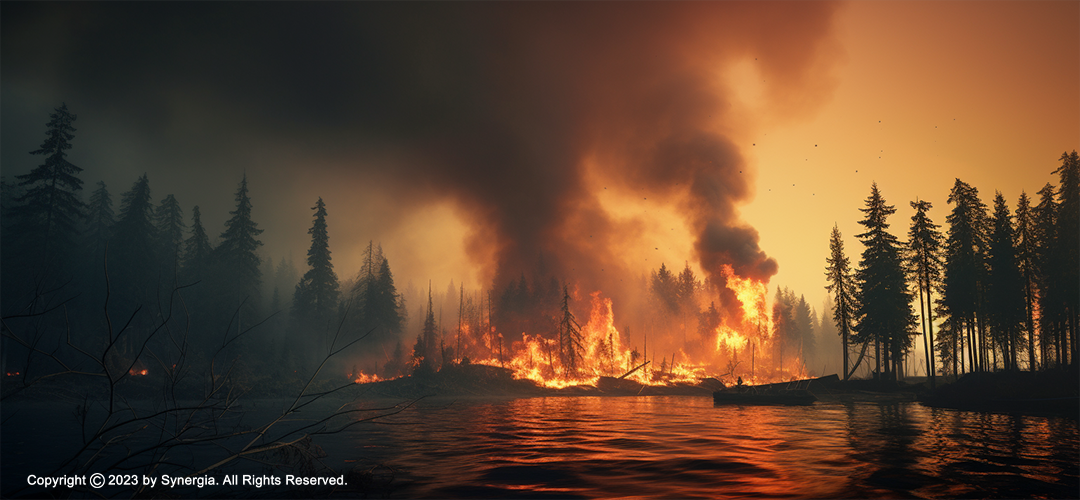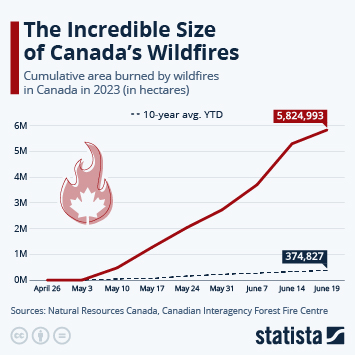Wildfires: Its Canada’s Turn Now
June 24, 2023 | Expert Insights

Canada is currently experiencing its worst wildfire season on record. As of June 21, 2023, there have been over 2,600 fires, which have burned over 5.2 million hectares of land. The fires have forced the evacuation of thousands of people and have caused billions of dollars in damage.
The wildfires in Canada are part of a global trend of increasing wildfire activity. Wildfires are becoming more frequent, more severe, and more destructive. This is due to a number of factors, including climate change, human activity, and changes in land use.
The government of Canada has responded to the wildfires by deploying firefighters, providing financial assistance to affected communities, and setting up evacuation centres. However, the fires are still burning, and it is not clear when they will be brought under control.
The wildfires have had a devastating impact on communities across Canada. In some cases, entire towns have been evacuated, and people have lost their homes and businesses. The fires have also caused air quality problems and led to flight cancellation and other events. Places as far as New York woke up to heavy smog, and Air Quality Index (AQI) plummeted dangerously.
Background
Climate change is a major factor contributing to wildfires' increasing frequency and severity. Climate change is causing the Earth's atmosphere to warm up, leading to drier conditions and more extreme weather events. This makes it more likely that wildfires will start and spread. For example, a study by the University of British Columbia found that the risk of wildfires in Canada is increasing by 10 per cent for every degree Celsius that the global temperature rises.
Wildfires in the boreal forest of northern Canada are often started by lightning. As the climate warms, lightning strikes are expected to increase. This is because warmer air can hold more moisture, leading to more thunderstorms. More thunderstorms mean more lightning strikes, which means more wildfires.
A study by the University of British Columbia found that a one-degree Celsius increase in temperature can lead to about a 12 per cent increase in lightning strikes. This means that if the global temperature increases by 2 degrees Celsius, as is projected, the number of lightning strikes in the boreal forest could increase by 24 per cent.
This is a serious concern, as the boreal forest is a vast and important ecosystem. It is home to a wide variety of species, and it plays a vital role in absorbing carbon dioxide from the atmosphere. If wildfires become more common in the boreal forest, it could significantly impact the environment and the climate.
Changes in land use can also contribute to the increasing frequency and severity of wildfires. For example, converting prairies to cropland can increase the risk of wildfires, as croplands are more likely to burn than prairies.
A study by the Pembina Institute found that the oil and gas industry is responsible for about 20 per cent of Canada's greenhouse gas emissions. These emissions trap heat in the atmosphere, leading to warmer and drier weather conditions, idle conditions to start and sustain huge wildfires. In addition, oil and gas-related infrastructure passing through pristine forest landscapes are disturbing the land, and increased human intervention makes forests more susceptible to fire.

Analysis
The economic impact of the wildfires is still being assessed, but it is estimated that the fires could cost the Canadian economy billions of dollars. The fires have already had a negative impact on the tourism industry, and the impact will likely be felt for years to come. The fires have also disrupted the oil and gas industry and have led to job losses in the sector.
In addition to the immediate impacts, wildfires can also have long-term impacts. For example, wildfires can release greenhouse gases into the atmosphere, contributing to climate change. They can also damage soil and water quality, hurting agriculture and ecosystems.
Some traditionalists have a unique perspective on these mega forest fires, which engulf millions of hectares and burn for weeks, if not months, in some cases. They claim that over-conservation and faulty management of forests have prevented the natural cleansing of forest floors through naturally ignited fires that burnt away excess ground vegetation and detritus prone to fires under dry and hot conditions, especially after long rainless periods. Earlier, this used to take place very frequently, and as a result, the size and extent of these fires were naturally controlled once the combustible vegetation was consumed. With fires being suppressed artificially, it allows for a build-up of the combustible vegetation, and when a fire is finally triggered by a lightning strike or by some careless camper, the consequences rapidly go out of control.
As per the American Wilderness Society, in the U.S., for many decades, the dominant strategy to prevent wildfires was to prevent them or fight them whenever they popped up, known as “fire suppression. Since some fires occur naturally in the wild, scientists now know that these fires can play an important role in an ecosystem, allowing a robust and varied cycle of plant growth and helping make forests more resilient in the long run. But because of a long history of short-sighted fire suppression policies, some areas, where less-severe wildfires once cycled through the landscape every so often as part of a natural process of rebirth and renewal, are now clogged with the plant material that ends up fuelling hotter, more destructive blazes.
Assessment
- Therefore, a more holistic view of the problem has to be taken, and there is a need for global collaboration. From the rich to the poor, from India to Brazil, and from North Africa to Europe, wildfires havee become more frequent and almost catastrophic. States must invest in proper forest management and prevention of wildfires, including resources, manpower and machinery, to combat them.
- They are offshoots of a larger global problem, climate change, and must become a part of the battle to save the Earth's environment. Land management practices must make our forests more resilient to fire and not less. This could include measures like thinning forests and reducing the amount of deadwood.
- Catastrophic flooding in Pakistan, back-to-back cyclones in the Pacific islands, and droughts in Africa have not been enough to create a tipping point for action. But will the climate impacts that have now hit the economic capital of Western power spur governments in the global north to get serious?








Comments